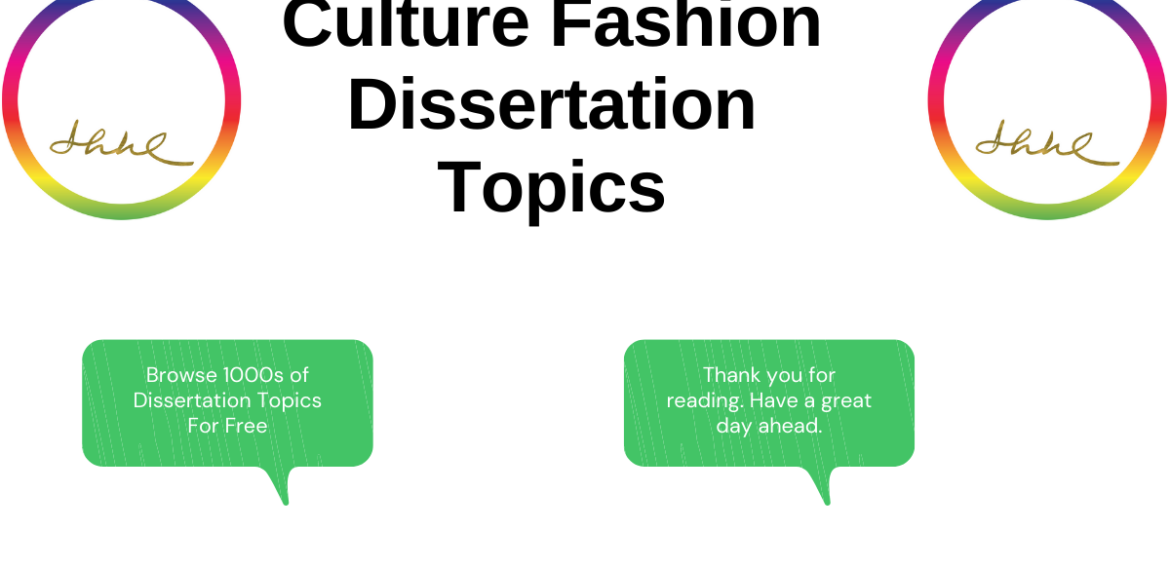Culture and Fashion Dissertation Topics
It’s difficult to disentangle culture and fashion because they’re so inextricably linked. People use clothing to express their ideas about personal relationships, power dynamics, and social hierarchies in their communities across cultures. Numerous and frequently intricate connections exist, necessitating sociological and psychological investigation. Selecting a dissertation topic that reflects your cultural and fashion interests will assist you in narrowing your focus while still allowing you to investigate a variety of research questions. Additionally, the topic you select should reflect both your personal concerns and interests and current research trends. We have compiled a list of culture and fashion dissertation topics that cover a variety of key areas. They are intriguing, one-of-a-kind, and manageable.
Editingarsenal has compiled a list of some of the most popular and common dissertation topics from a variety of academic disciplines, so you can pick and choose what to write about. If you need dissertation editing assistance , don’t hesitate to contact one of our qualified and experienced editors and proofreaders.
Clothing and Leisure Topics
- Athleisure has grown in popularity since COVID-19.
- The meteoric rise of vegan leather.
- When it comes to labelling and branding, it’s all about how you present yourself.
- Marketing’s influence on today’s fashion industry.
- The use of recycled or recyclable materials in club wear.
- The gap between attitudes and behaviours regarding sustainable footwear is being examined.
- Today’s tartans: Color and pattern have symbolic meanings.
- The evolution of fur as a fashion accessory.
- Myths and realities of hunting clothing.
- Shakespearian plays’ aesthetic image reflects current fashion trends.
- The Lord of the Rings: How to translate: The costumes have remained consistent from the book to the screen.
- A look back at the hat’s vibrant history.
- Hats are worn by magicians, witches, and Ascot.
- Changing Times: The century-long bridging of the rural-urban divide in fashion.
- Since the early eighteenth century, wigs, rings, and tails have been used as status symbols.
- Since 1800, the tuxedo and suit have been critical components of formal attire.
- Science fiction-inspired fashion and style.
- Swimwear dating all the way back to the dawn of time.
- This is the ballgown’s history.
- In the United Kingdom, the uniform has evolved over the last century.
- An examination of the fashion lines endorsed by prominent members of the media.
- What function does the heel perform? Fashion for high-heeled shoes throughout history.
Sex and Body Topics
- The power suit’s history.
- Since the 1950s, the fashion industry has had an equal representation of men and women.
- Body piercing and tattooing in western societies: a critical examination of their symbolic significance.
- Fetish clothing occupies a prominent position in today’s fashion scene.
- An examination of the debates surrounding what constitutes appropriate dress in terms of culture and religion.
- Is hair and makeup really necessary?
- People have been dressing up as someone else since the Victorian era.
- The real and the subversive are not synonymous. Since the 1960s, mannequins and models have been used.
- The importance of an effective presentation cannot be overstated. A catwalk is composed of several components, among which are models, lighting, and cameras.
- The way sex, gender, and the body are portrayed in the media.
- A study of how people’s clothing conveys information about their social status, power, and aspirations.
- examining the influence of nudist fashion on one another.
- Clothing worn by monks and nuns throughout history: a lifelong habit.
- How much of contemporary fashion is concerned with looking good even when completely naked?
- Can we attribute transgender models’ popularity to popular fashion design?
- Plus-size fashion is a reflection of the obesity epidemic.
- Clothing that is gender neutral: a fad or a necessity?
Iconography Topics
- Recognize a fashion icon is similar to peering through a window into another world.
- Are you a social media fan of the Kardashians? The Kardashians’ influence on the fashion industry is examined.
- Kate Middleton, Duchess of Cambridge, is a style icon of the modern era.
- Meeting Marilyn Monroe, one of the world’s most stylish women, in retrospect.
- Hepburn, De Givenchy, and Haute Couture are just a few of the most well-known fashion names.
- The Caf Society in James Dean’s Films
- Fashioning the Elite: What Hubert de Givenchy’s lifelong friendship with Audrey Hepburn contributed to the world of fashion.
- The pop culture highs and lows of Madonna’s era.
- If looks could kill, Kylie Minogue and the pop princess image would.
- In the documentary Fashioning an Idol, boy band culture and adolescent fashion collide.
- Eminem’s style as a rapper: Eminem’s style as a rapper: Rapping the fashions of a culture.
- Elvis introduced the world of fashion to glitz, glam, and an ever-expanding waistline.
- Today, Beatlemania and swinging ’60s fashion remain popular.
- Westwood, The Sex Pistols, and Punk.
- What celebrity culture has meant for high-end fashion.
- Designers continue to be inspired by Jane Austen’s novel “Pride and Prejudice.”
- Fashion icons and their signature looks.
- Celebrities as role models for fashionable dressing.
- How sneakers have grown in popularity over the last few years.
- Is it possible for women over the age of 70 to be style icons in the modern era?
- How much of a role does plastic surgery play in becoming an icon?
- In a time of gender fluidity, understanding androgenous style icons is critical.
History of Fashion Topics
- Englishness with a dash: the evolution of British style over time.
- Mods, Rockers, and other subcultures defined the era of the adolescent rebel.
- Fashions from the era of liberalism, the Roaring Twenties.
- During World War II, fashions in the United States and the United Kingdom.
- Street style in the United Kingdom and the United States during the 1950s.
- It was the 1960s, which meant a plethora of vibrantly coloured clothing and accessories.
- A look back at the 1970s fashion icons and their contributions to the industry.
- Fashion in the 1980s reflected the decade’s political and cultural ideals.
- Teenagers’ clothing in the 1990s.
- Are you on a quest to accomplish a distant goal? Outfits inspired by the future.
- Royal attire reflects the diverse identities of monarchs worldwide.
- “The Cobbler and the Tailor”: Disappeared professions.
- Men’s fashion from the 1700s to the present day is examined historically.
- Our enduring fascination with clothing from the Victorian era.
- The English wedding gown’s history can be found in the book Material Marriages: Their Origins and History.
- The symbolic elements of Greco-Roman fashion.
- Markets and bazaars in London are teeming with ethnic clothing.
- Fashion played a significant role during the Tudor and Stuart dynasties.
- Peasant dress has evolved over time.
- Throughout history, fools and jesters have existed.
- A history of women’s footwear.
- Discuss the influence of retro fashion on today’s industry and the extent to which it has influenced it.
- Primark’s arrival heralds the arrival of low-cost fashion.
- The Royal Family of England as style icons of the modern era.
- Children’s clothing has evolved significantly over the last two decades.
- Wedding attire for twenty-first-century ‘alternative’ couples.
- Bathing suits have evolved over time.
- The current state of the fashion industry and possible solutions.
- Androgyny is a self-contained fashion industry statement.
- Goths and gothic fashion are extremely popular at the moment.
- Steampunk’s rise to prominence and current relevance.
- The application of jewellery in the world of haute couture.
Co-Creations in Fashion Industry Topics
- “No one of us is as strong as all of us”: co-creation in the fashion industry.
- Co-creation in the fashion industry via social media: a case study.
- An examination of the cultures of co-creators and their impact on small and medium-sized fashion brands.
- A case study of Zara and co-creation with customers.
- Luxury brands and co-creation: a brand equity case study.
- Collaborations between the fashion industry on a national and international scale.
- How far has digital technology aided the collaborative efforts of global fashion designers?
- Is repurposing clothing a viable strategy for combating fast fashion?
- When science and fashion collide, a transdisciplinary collaboration occurs.
- Is the ‘culture of co-creation’ in the fashion industry the way of the future?
- Circular economy and co-creation of fashion.
Covid-19 Impact on Fashion Industry Topics
- What role did digital innovations play in sustaining the creative industries during the pandemic?
- Are museums experiencing a renaissance? A strategy for resilience in the years 2021-2025.
- As a result of the COVID pandemic, new connections between culture, education, and health have been established.
- Urban and regional creative recovery following COVID-19.
- In comparison to many other industries, why was COVID so detrimental to the creative industries? A thorough investigation has been carried out.
- Is this a wake-up call for fast fashion and the COVID-19?
- COVID-19 is ushering in a new era of loungewear and activewear.
- Investigating fashion students’ perceptions of their future career options following COVID-19.
- Protesters left graffiti and other artefacts in their wake during the COVID-19 lockdown.
Design Material Topics
- A look at the humble underwear’s evolution.
- PVC carries a range of connotations, both positive and negative.
- Clothing and accessory trends and synthetic materials.
- Reliance on the wool trade by the western fashion industry.
- The historical significance of the bodice.
- The eras of mini and maxi skirts have passed us by.
- Women in public service are increasing in number, as is the number of health and safety regulations.
- Materials that matter: an examination of how materials have evolved since the nineteenth century.
- The history of wool and its current applications date all the way back thousands of years.
- The 1950s introduction of nylon and its impact on fashion.
- Is this a place where fair trade is practised? Cotton and hemp production in the United Kingdom, as well as the domestic market for these products.
- Natural fabrics such as leather and cotton are currently a source of contention over their morality and utility.
- What is it about shoes that people find appealing? A study of how women and men feel about their shoe selections.
- Accessories make statements. What a difference different materials have made in the design of accessories.
- I am enchanted by the sari. Over time, material designs and adaptations have undergone numerous changes.
- Distressed fashion from the 1990s to the present day is a message in distress.
- Where is the style in hats and horse racing?
Children’s Clothing Topics
- Cinderella, Sleeping Beauty, and other well-known fairy tale characters.
- What do you mean by “too brief”? An examination of the public discourse’s arguments for and against prostitution and children’s clothing.
- Superheroes are an excellent way to incorporate symbolism and representation in general.
- Halloween is a time for children to dress up and engage in imaginative play.
- Baby Boomers grew up in a postwar world defined by postwar culture and infant fashion.
- Because everyone else is, why should we be any different? Examining the effect of fashion advertising on the health of children.
- Substituting natural symbols and emblems for man-made ones.
- Investigating why colour has such a strong influence on fashion.
- It all began with children’s clothing, which was the first to feature the motif.
- Chains, t-shirts, and baggy pants are all symbols of skateboard culture in children’s clothing.
- Alice’s Adventures in Wonderland: The dress’s dwindling popularity among young females.
- Fairies and pixies have an uncanny ability to pique people’s imaginations.
- Is it necessary for children to be dressed in non-binary clothes?
- Gender stereotyping in children’s clothing, with boys wearing blue and girls wearing pink.
- Is children’s fashion reflective of today’s social climate? The study of child fashion from the Victorian era to the present. examination of child fashion.







